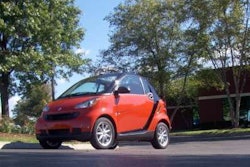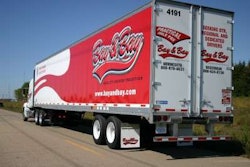Advanced braking systems come of age
Which is more important? Getting a truck laden with goods rolling? Or stopping said truck once it’s under way? In a sense, you can’t argue with the notion that a safe stop is most important. Truck builders and operators have waited years for an update of the National Highway Traffic Safety Administration’s stopping distance standards for truck tractors. They likely will wait longer, as the Bush administration failed to complete the ongoing rulemaking before it left office last month.
When it comes to stopping trucks, government trails the private sector. Companies that supply brakes to the trucking industry and integrate braking into other safety systems already are putting safer trucks on the road, and there’s more to come.
Government backs further progress
Rear-end collisions account for about 20 percent of all heavy-truck crashes, and the truck is the striking vehicle in 60 percent of those accidents, says Jon Morrison, president and general manager of Meritor Wabco Vehicle Control Systems.
According to studies conducted by Meritor Wabco, inattention or poor decisions – such as driving too fast for conditions, or following too closely – are the primary factors in 66 percent of the collisions where fault is assigned to the truck driver. “Our experts estimate that 90 percent of all rear-end collisions can be eliminated if the driver has one additional second of reaction time,” Morrison says. So technology such as this is proven to save lives – yet only 8 percent of Class 8 tractors in North America currently are equipped with technology that can reduce the likelihood of a rollover accident, he says.
NHTSA’s proposed changes to Federal Motor Vehicle Safety Standard (FMVSS) 121 would cut stopping distance by 20 to 30 percent. This isn’t as stringent as what NHTSA could have proposed, but it will spur a new look at braking technology – and it’s not necessarily where NHTSA will end up.
“This regulatory activity will certainly spur advanced wheel-end braking technologies, such as air disc brakes,” says Fred Andersky, director of marketing for Bendix Controls Group. The company also anticipates NHTSA will consider rules regarding stability systems for commercial vehicles, Andersky says.
Legislation introduced in the last Congress would have required motorcoaches to employ advanced safety technologies such as stability systems and adaptive cruise control. Another bill introduced in both the House and Senate would have provided tax credits to fleet owners for placing into service advanced commercial vehicle safety systems, such as brake-stroke monitoring, stability, collision warning or lane departure systems. It’s likely that those measures will resurface in the new 111th Congress.
While Bendix prefers to allow the market to decide the success or failure of safety technology applications for commercial vehicles, “there is no denying the fact that regulations will continue to contribute to the growth and evolution of these technologies,” Andersky says. For example, FMVSS 121 spurred the growth of antilock braking system (ABS) technology for commercial vehicles. The growth of ABS for commercial vehicles has built a foundation for advanced technologies, such as stability systems, adaptive cruise control systems and additional “active safety” technologies that utilize the brakes in some fashion to help slow or redirect the vehicle and help mitigate potential accident scenarios, Andersky says.
The technological curve means that new systems are appearing all the time and that exponential leaps forward now seem to be the norm. At this month’s Technology & Maintenance Council meeting in Orlando, Fla., Meritor Wabco will demonstrate a new “always on” Autonomous Emergency Braking (AEB) system. Early reports indicate the system integrates data from video and laser distance sensors to simultaneously interface with a truck’s engine, transmission and stability control systems to detect, analyze and react to moving and stopped vehicles. Wabco says the system minimizes the response time for a vehicle to brake during collision-imminent situations because the AEB system reacts faster than the driver, ensuring the most effective deceleration and bringing the vehicle to a complete stop if necessary.
“Clearly, you can’t overstate the safety aspect these systems bring to the table,” says Randy Petresh, vice president of technical services for Haldex. And it’s clearly critical since federal agencies and elected officials pound the same theme home constantly – but Petresh says there is a practical side to this technology. “The stability and anti-rollover capability that we now have available is a tremendous improvement in terms of cost savings and productivity increases for a lot of fleets – especially those fleets that are particularly susceptible to rollover accidents and stability issues due to the type of equipment they use and the loads they carry,” he says.
Haldex is working actively with fleets to refine its integrated brake system products. “Those fleets are experiencing not just potential savings, but real savings in terms of the reduction of incidents, accidents and rollovers,” Petresh says. “In some cases, those savings are tremendous. If you roll over a tanker with the wrong stuff in it, you’re looking at a seven-figure cleanup cost. And unfortunately, tanker rollovers happen frequently. So there are dramatic costs associated with advanced braking technology.”
The ultimate cost-control tool?
Government regulation isn’t the only factor driving the development of advanced braking technology. In fact, such systems are good for a fleet’s business. Accidents cost money – both directly and indirectly – and that reduces profitability. Direct costs tie to the factors that impact the bottom line, including equipment repairs, driver and truck downtime, and insurance and lawsuit costs, to name a few. Indirect costs, which are harder to quantify, tie to the fleet’s reputation and, in turn, its ability to drive additional business.
Showing up in the news because of an accident or failing to deliver a customer’s critical shipment on time because of an accident can seriously damage a fleet’s reputation. In today’s competitive business environment, reputation can mean the difference between gaining business and losing it to a competitor that is perceived as “safer.” An accident can mean delayed or damaged merchandise, which impacts shippers and leads them to consider other fleets for their business. The advancement of braking system technologies can help fleets make progress both in reducing costs and in driving a positive business perspective, Andersky says.
“Over time, you can quantify the savings these systems offer you,” Petresh says. “Fleets that run well-controlled systems with good maintenance programs know the costs that accidents incur on their operations. And over time – be it six months, a year or two years – they know how many incidents that they would have had in the past that they no longer have thanks to integrated braking systems.”
Active safety systems help mitigate accidents, Andersky says. “Reducing accidents ultimately reduces costs.” If a fleet is self-insured, the savings go right to the bottom line; if it’s insured, the addition of active safety systems is but one element that can help reduce the risk profile to an insurance company and potentially lower premium costs.
According to Bendix research, a fleet operating on a 5 percent gross margin needs to generate an additional $2 million in revenue for every $100,000 in accident costs. The more expensive the accident, the more revenue required to cover the cost. “In these tough economic times, a small investment in safety technology can return great dividends in helping fleets reduce accident-related costs,” Andersky says.
In addition, initial testing by Bendix on some active safety technologies indicates they may deliver improvements in fuel efficiency. And because many of these technologies build on the current ABS system, they require little – if any – additional cost for maintenance and repair. “Often, the procedures required to keep the braking system in good working order are identical to those required to keep the advanced braking system, or active safety technologies, in good working order,” Andersky says.
Evolving technology
In the past, collision-avoidance systems used lights and sounds to warn drivers. And while those warnings were and remain a plus, their value is lost if the system creates false warnings or if the driver is distracted by other devices in the cab, such as a loud stereo.
That’s why the current push is to develop adaptive cruise control systems that not only provide warnings to the driver, but also intervene proactively to help drivers avoid a variety of situations. They take the additional step of utilizing the braking system to help maintain safe following distances. Care is taken to ensure that the driver never relinquishes full control of the vehicle to a computer; rather, the computer steps in to assist the driver when events begin to spin beyond human control.
“We’re not talking about pie-in-the-sky stuff – some technology that’s in development and is years and years away,” Petresh says. “For the most part, this technology is here today and quite viable.” Haldex understands that adding new technology is not foremost on fleets’ minds given the current economic climate, but there is a long list of factors – such as legislative pressures, driver retention and sociological factors – that is driving the acceptance of advanced braking systems. “When you look at all those things – and you have to if you’re in the trucking business – you quickly realize this technology is going to continue to evolve,” he says. “And if your competitors are using it now, you’re going to get left behind businesswise if you don’t start working with it. It’s not a question of will this happen. It’s a question of how soon will this happen?”
It’s a given that economies of scale soon will make advanced braking systems such as air disc brakes and rollover avoidance technology more affordable for fleets. But the technology already has evolved to the point where affordable retrofit systems now can be added to tractors and trailers alike.
“We see an immediate need for practicable retrofit for tractors,” Morrison says. “That’s why Meritor Wabco has targeted trailers as the best, most cost-effective opportunity to apply stability technology to vehicles already in service.”
Meritor Wabco’s new trailer-based stability control is managed by the electronic control unit (ECU) and incorporates the ABS. The ECU contains an accelerometer that measures lateral or side-to-side movements of the vehicle. As the trailer rounds a curve or is involved in a sudden steering maneuver, the ECU is continually calculating the trailer’s roll stability threshold based on lateral acceleration and individual wheel speeds. Before a rollover is imminent, the system automatically will apply the trailer-axle brakes, slowing the vehicle to reduce lateral acceleration and restore control to the driver.
It does so with precision in a turn or steering maneuver: When lateral acceleration begins to push the vehicle horizontally and the load from the tires on the inside of a turn shifts to the tires on the outside, and a calculated lateral acceleration threshold is being exceeded, the system automatically will deliver greater braking force to the individual wheels that bear the heavier loads to stabilize the vehicle. The ABS ensures that the wheels do not lock up.
“This process occurs independently from the tractor, which may or may not have a stability system of its own,” Morrison says. “It also can happen without intervention from the driver.”
Calculating the costs
A problem with calculating return-on-investment is that many fleets have not been forthcoming with the necessary data, Petresh says. “Most of these fleets are holding this data close to their chests right now for a variety of different reasons – mainly fear of government intervention,” he says. “But as this ROI data becomes common knowledge, it’s going to help drive other fleets to try this technology for themselves.”
Still, some data is available for public consumption, and it is encouraging. Andersky cites a June 2008 webinar entitled “Preview of Costs and Benefits of Onboard Safety Systems,” in which FMCSA indicated the ROI on rollover stability systems was that for each $1 spent, the return is $1.93 at 23 percent efficacy, with a payback period of 29 months.
Many fleets that add full-stability systems to their vehicles indicate that if the technology prevents just one accident, the cost savings will cover the cost of the equipment for the entire fleet, Andersky says. “The additional coverage offered by full-stability systems – such as helping mitigate loss-of-control situations that often result in rollovers – can provide an even larger ROI and faster payback for some fleets,” he says.
Helping drivers drive better
Today’s braking systems watch what happens on the road
Thanks to the power of their electronic brain boxes, advanced braking systems also can be used to educate drivers and mold their behavior. Isuzu’s Memomori system – currently available in Japan, but slated for introduction in the United States in the near future – is a prime example. “Using GPS tracking and an easy-to-use Internet-based interface, fleet managers can now identify poor driving habits in the real world and correct them before an accident occurs,” says Todd Bloom, vice president of sales for Isuzu Trucks North America.
Isuzu is working to create fully integrated brake systems that not only will apply brakes proactively in a potentially dangerous situation, but also will send a signal immediately to a cell phone or computer to alert a fleet manager that an unwanted “event” has occurred.
Bendix’s braking systems have similar capabilities, which are as important to fleet operations as the proactive braking technologies that help drivers out on the road, says Fred Andersky, director of marketing for Bendix Controls Group. “Information relative to advanced technologies such as stability and adaptive cruise control is crucial in helping fleets understand driver behaviors and tailor training to address specific needs,” Andersky says. “And it’s beneficial not only to new drivers, but also to more experienced drivers who can gain important tips through evaluation of system data.”












